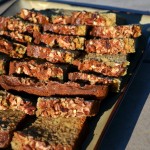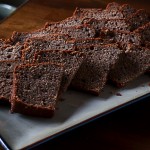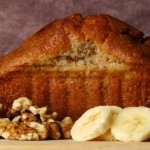Monthly Archives: April 2013
Reading Reflection #2
After reading a lot of this book it has really changed my perspective on bread, let alone all of the history that comes along with it. People say that everyone has their own life story and now that I think about it so does food and all the ingredients it took to make that food.
Bread has a connection with just about every piece of history that you can think of. Somehow, somewhere bread had an impact on our history whether it be religious, laws, beliefs, good health, bad health, war, slaves, work and probably plenty more in the future.
The things that have really stuck with me while reading this book are the little facts about bread and its process of being made and how it has made its way through history. The roman engineers invented the water mill. Barbarians hated the mill but the Egyptians loved it and looked at millers as if they were magicians. However people grew to really dislike millers. People suspected that they stole grain from them. No one will ever truly know if millers stole grain because only the millers knew what they had done and if they were stealing grain from the towns folk they definitively were not going to turn themselves in.
Another fact that sticks out to me was that it wasn’t easy to become a baker. Anyone that wanted to be a baker had to do a lot of things before he could even have the chance to becoming a baker. First the baker had to be legitimate at birth to even enter the trade then there was a brief prohibition period before he could sign his articles. Apprenticeships for two to three years then indentures were signed and he was a journey mad out to study the art and techniques of baking from different places. When he returned he had to wait for a house to have a vacant “baking privileges” which meant that a baker had to die first. Bakers had a lot of health problems from not getting enough sleep, not eating enough and constantly breathing in flour. Bakers often developed Bakers asthma and bakers eczema.
First Reading Reflection
Six Thousand Years of Bread (Jacob 2007) is a lengthy read packed full with history and information about agriculture, grains, religion and the beginning of bread in human history. Arranged as a set of “books” from prehistory to “bread in our time,” the content jumps around not focusing on any one element of bread as we know it.
On the very first page is a quote by Henry Fabre, “History celebrates the battlefield whereon we meet our death, but scorns to speak of the plowed fields whereby we thrive; it knows the names of kings’ bastards but cannot tell us the origin of wheat. That is the way of human folly.” We really don’t know precisely where the origin of our food comes from; neither are we taught about food and its history in school. Learning about the history of something that we are in contact with every day of our lives is essential: bread isn’t going to disappear very soon.
Six Thousand Years of Bread informs us that Dr. Gideon Lincecum claimed that ants were the first reapers and sowers of grain, but it turns out that what he had observed was an accident of ant behavior. Stone age man was the first sower of grain, again an accidental occurrence; agriculture was discovered when early man threw out seeds that began to germinate because the taste was spoiled. Eight months later to his surprise the grain showed up again.
In mythology, the Greek gods are connected to agriculture and bread making. When Demeter’s daughter Persephone was snatched into the underworld, Demeter made all fields unfruitful; she wouldn’t let the seed rise; men, animals, and the gods couldn’t live without those essential plants.
But how did grain become converted to bread? It was the Egyptians who first invented ovens, making the transformation of grain possible. The Egyptians went as far as basing their administrative system around bread. With parallel importance, the Jews made bread the starting point of their religious and social laws, while the Greeks created profound and solemn legends for the Bread Church of Eleusis. Bread has a long and vital importance as a symbol of power, story, and growth.
I feel like if this book was written well but I wish it would have been written in a different order. I would have really liked it to keep all the same topics or subjects to be kept together in a chapter I feel like it would have made it a lot easier for me to read and follow along.
Delicious Gluten Free Banana Bread
1 ½ cups gluten free all-purpose flour
½ cup rice flour
1 teaspoon baking soda
4 eggs, beaten
3 mashed bananas
1 cup sugar
½ unsweetened applesauce
1/3 cup of coconut oil
1 teaspoon vanilla extract
½ chopped pecans
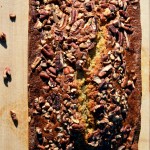
In a separate small bowl, add in the beat
Add ingredient of small bowl to flour bowl, stirring just until mixture becomes moistened.en eggs, mashed bananas, sugar, oil, vanilla and applesauce, stirring until well combined.
Grease two 8×4 loaf pans and pour batter evenly into pans. Top each pan with pecans and bake in 350 degree F. oven for 50 minutes or until you can poke a toothpick into center of loaf and have it come out clean. Remove from oven and allow to cool 10 minutes before transferring to wire racks or serving plates.
Cherry Chocolate Banana Bread
- Cherry Chocolate Banana Bread
½ cup butter
1 cup sugar
2 eggs, beaten
3 mashed bananas
1 ½ cup all-purpose flour
1 teaspoon baking soda
¼ cup chopped nuts
¼ cup miniature chocolate chips
¼ cup chopped maraschino cherries
1 teaspoon of coconut extract
Preheat oven to 350 degrees F.
In a large bowl, cream butter and sugar until smooth and fluffy. Stir in beaten eggs, mashed bananas, flour and baking soda until well blended. Next add nuts, chocolate chips, cherries and coconut extract, stirring until evenly combined.
Grease a 9×5 loaf pan or spray with non-stick cooking spray. Pour batter inside pan and bake in 350 degree F oven for 60 minutes or until you can insert a toothpick in the center of the loaf and have it come out clean.
Remove from oven and allow to cool for 10 minutes before transferring to wire rack or serving plate.
Simple but Delicious Banana Bread
- Week 1 Banana Bread

1/2 Cup Vegetable Oil
1 Cup Sugar
2 Eggs, lightly beaten
3 Ripe Bananas, mashed
2 Cups All-Purpose Flour
1 Tsp. Baking Soda1/2 Tsp. Baking Powder
1/2 Tsp. Salt
3 Tbsp. Milk
1/2 Tsp. Vanilla Extract
Add desired amount of cinnamon if wanted
Preheat oven to 350 degrees F. Place oil in large bowl. Add sugar while beating lightly, Add eggs and continue beating. Add mashed bananas and beat just until moistened. Set aside. In a separate bowl, combine the flour, baking soda, baking powder, and salt. Add the dry mixtu
re to the banana mixture and beat just until moistened. Add the milk and vanilla extract and continue beating just until mixed. Pour mixture into a greased and floured 9×5 loaf pan and bake 50-60 minutes or until toothpick comes out clean.
Cherry Chocolate Banana Bread
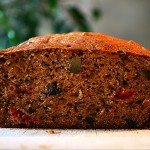 This week I have chosen to focus my food photography on recipes and lighting basics. I have learned that recipe shots are the most common form of food photography and that the photos can be of the finished dish, the ingredients used to make the dish or the preparation of the dish. I also learned the different types of basic lighting and what kind of image you will get depending on where you place the light. I continued to use a tripod and a cable release cord. I sliced the bread and arranged the subject/s where I wanted them to be. I placed the bread on the kitchen table near the sliding glass door again and I chose to use the side lighting technique because after looking at the way the bread looked when I tried
This week I have chosen to focus my food photography on recipes and lighting basics. I have learned that recipe shots are the most common form of food photography and that the photos can be of the finished dish, the ingredients used to make the dish or the preparation of the dish. I also learned the different types of basic lighting and what kind of image you will get depending on where you place the light. I continued to use a tripod and a cable release cord. I sliced the bread and arranged the subject/s where I wanted them to be. I placed the bread on the kitchen table near the sliding glass door again and I chose to use the side lighting technique because after looking at the way the bread looked when I tried
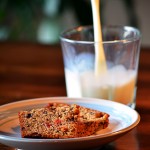
other techniques I had liked this one the most. It made the bread look like it has a warm feel to it and made it look extremely appetizing. I placed a basic desk lamp to the side about a couple feet away and began taking multiple different photos. After getting a few photos that were different than last weeks I began editing them in photoshop. This time I adjusted the levels, applied a high pass filter and bumped up the contrast and the saturation just a little.
First Banana Bread Photos
This was my first time trying out food photography. I can definitively say that I am quite happy with the results for not having any experience in this field of photography. For this week I decided to focus on natural lighting and websites, blogs and ebooks style of photography. I read in my book that most of the food photography photos you see are normally taken in natural lighting. I learned that the best place to photograph is in the garage. This is because you can control the amount of light you let fall onto your subject. I however didn’t want to photograph my bread in the garage… It just does not seem sanitary in the dirty garage. So after reading a few small sections in my book I put what I had read to the test. I waited for the bread to cool down before I started photographing it. I’m using a Nikon D5100 to shoot my photographs. I set up my bread on the kitchen table near the sliding glass door and made sure I had plenty of room to start my photography shoot as well as making sure there wasn’t much that would be showing up in the background. I started to arrange the bread at the angles that I wanted it to be viewed and set up my camera to a tripod. I used a cable release cord to make sure my photos would turn out 100% sharp since I was shooting in manual mode with no flash and the shutter speed was pretty slow. When I decided I finally had some photos I was happy with I began editing my photos in photoshop. I really don’t like to over edit my photos and would rather keep them looking as natural looking as the original image. All my editing consists of is adjusting the levels, applying a high pass filter and cropping out the unwanted content.


